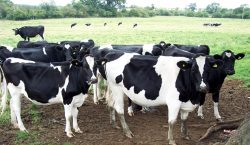

Kotze is one of Zimbabwe’s best loved and admired artists, and his unusual take on everyday objects and familiar scenes, coupled with his attention to detail and painterly skills, has endeared him to collectors at home and abroad.
In a short but emotional speech, Kotze spoke of the time and effort invested in creating a body of art required for the exhibition. Each large canvas took at least six weeks to complete, and when the canvases were eventually transferred to the gallery, he felt as though his much-loved offspring were leaving home.
Apart from the smiling woman on the 10kg Peoples Choice mealie meal bag, subject of the painting The Peoples Choice, I detected no female forms in this exhibition of Kotze’s paintings. Watermelons, magaka, tins of pilchards, and the vendor selling lilos and blow up ducks all feature among his chosen subjects. This is not to imply that the artist lacks a feminine side: In the impressive exhibition catalogue, Kotze’s tributes to the women who helped in his transition from engineer to renowned artist are heartfelt and touching. Studies depicting the female form may belong to an earlier era, or perhaps they are yet to come.
For now, this artist’s fascination is with nature, or with found objects, which at a glance might be considered trash. The crushed cans of Zambezi and Castle beers, haphazardly piled into a cardboard box and entitled Yes, We Can, have a luminous presence reminiscent of the work of Ghanaian artist El Anatsui, whose wondrous metallic Kente cloth can be seen at the Fowler Museum at UCLA. Using the metal openers of cool drink cans, Anatsui shows how discarded everyday materials can be stitched together to create a tapestry.
In Pots Calling Kettle, a collection of well-worn enamel cooking pots are grouped around an ancient lidless kettle. Countless meals have been cooked over fires in these long handled pots: No longer useful in the kitchen, their only beauty is in the eye of the artist.
How easy it is to admire the luscious fruits of Melon Drama. The crunch of the sharp kitchen knife slicing into the ripe fruit is almost audible, and one can sense the juicy interiors of all the other melons, piled up on the roadside.
In Pumpkin Patch, the golden, green and white orbs have been harvested from the fields, ready to be carried into the kitchen and roasted in the oven, or transformed into pumpkin pie.
This exhibition is not without sophistication – the painting of countless pairs of elegant shoes displayed to perfection beneath bright lights on glass display counters, would arouse feelings of longing in any woman, and impress even Imelda Marcos.
Kotze’s exhibition would not have been possible without generous funding from a number of donors who understand the importance of promoting art and assisting artists. Farai Mpfunya spoke briefly about the Culture Fund and its dedication to art in Zimbabwe. He also referred to the two-week workshops conducted by Kotze in Mbare, as a way of giving something back to the community. Three different groups of young students were taught how to prepare frames and canvases before being instructed in the techniques of oil painting.
It will be interesting to see in which direction Kotze’s inspiration will take him. Will he immerse himself in more beautiful images from nature or will he further deconstruct artefacts like the metal pieces in Iron Curtain or Beaten Drum? In our overcrowded planet, El Anatsui’s suggestion that “artists are better off working with whatever their environment throws up” could be a way to provide space for future generations.